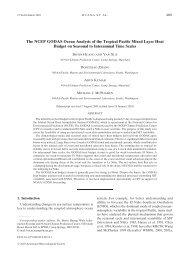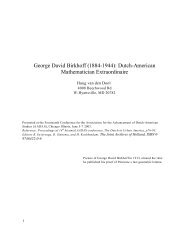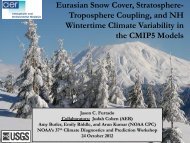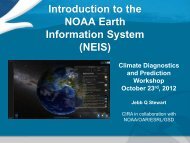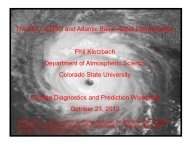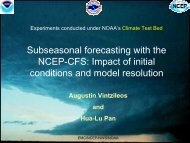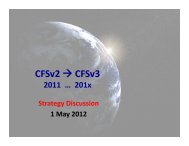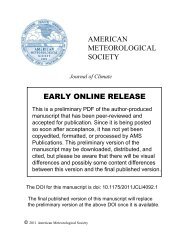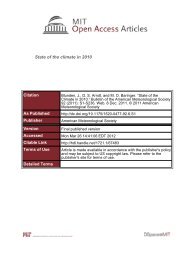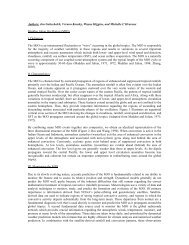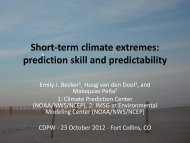Troposphere-Stratosphere Coupling (Perlwitz) - Climate Prediction ...
Troposphere-Stratosphere Coupling (Perlwitz) - Climate Prediction ...
Troposphere-Stratosphere Coupling (Perlwitz) - Climate Prediction ...
You also want an ePaper? Increase the reach of your titles
YUMPU automatically turns print PDFs into web optimized ePapers that Google loves.
Evaluation of <strong>Troposphere</strong>-<br />
<strong>Stratosphere</strong> <strong>Coupling</strong> in<br />
CFSv2<br />
Judith <strong>Perlwitz</strong> (University of Colorado and<br />
NOAA/ESRL)<br />
Amy Butler, Craig Long and Emily Riddle<br />
NOAA/NCEP/CPC<br />
Tiffany Shaw (Columbia University)
Outline<br />
• Background<br />
• Data sources<br />
• Lower stratosphere polar vortex in CFSv1<br />
and v2<br />
• <strong>Stratosphere</strong>-troposphere coupling<br />
• Summary and conclusions<br />
• Way forward
NAS Assessment of intraseasonal to interannual (ISI) <br />
climate predic7on and predictability <br />
• Opera&onal ISI predic&on models should be improved <br />
to represent stratosphere-‐ troposphere interac&ons. <br />
• Rela&vely long-‐lived (up to two months) atmospheric <br />
anomalies can arise from stratospheric disturbances. <br />
• In sensi've areas such as Europe in winter, experiments <br />
suggest that the influence of stratospheric variability on <br />
land surface temperatures can exceed the local effect of <br />
sea surface temperature. <br />
• Addi'onally, while our weather and climate models do not <br />
o@en resolve or represent the stratospheric Quasi-‐Biennial <br />
Oscilla'on very well, it is one of the more predictable <br />
features in the atmosphere, and it has been found to <br />
exhibit a signature in ISI surface climate.
Downward progression of Northern Hemisphere Annular <br />
Mode (NAM) <br />
(Baldwin and Dunkerton, 2001) <br />
• Extreme events in the stratosphere are followed by anomalous <br />
paGern at the surface that resemble the NAM <br />
• Extreme stratospheric events may provide forecast poten'al for <br />
weak 3 to 4
NAS Assessment of intraseasonal to interannual (ISI) <br />
climate predic7on and predictability <br />
• Opera&onal ISI predic&on models should be improved <br />
to represent stratosphere-‐ troposphere interac&ons. <br />
• Rela'vely long-‐lived (up to two months) atmospheric <br />
anomalies can arise from stratospheric disturbances. <br />
• In sensi&ve areas such as Europe in winter, experiments <br />
suggest that the influence of stratospheric variability on <br />
land surface temperatures can exceed the local effect of <br />
sea surface temperature. <br />
• Addi'onally, while our weather and climate models do not <br />
oen resolve or represent the stratospheric Quasi-‐Biennial <br />
Oscilla'on very well, it is one of the more predictable <br />
features in the atmosphere, and it has been found to <br />
exhibit a signature in ISI surface climate.
NAS Assessment of intraseasonal to interannual (ISI) <br />
climate predic7on and predictability <br />
• Opera&onal ISI predic&on models should be improved <br />
to represent stratosphere-‐ troposphere interac&ons. <br />
• Rela'vely long-‐lived (up to two months) atmospheric <br />
anomalies can arise from stratospheric disturbances. <br />
• In sensi've areas such as Europe in winter, experiments <br />
suggest that the influence of stratospheric variability on <br />
land surface temperatures can exceed the local effect of <br />
sea surface temperature. <br />
• Addi&onally, while our weather and climate models do <br />
not oFen resolve or represent the stratospheric Quasi-‐<br />
Biennial Oscilla&on very well, it is one of the more <br />
predictable features in the atmosphere, and it has been <br />
found to exhibit a signature in ISI surface climate.
Role of the <strong>Stratosphere</strong> in the<br />
<strong>Climate</strong> System<br />
• <strong>Troposphere</strong> and stratosphere are closely <br />
coupled with impact of the troposphere on the <br />
stratosphere domina7ng. <br />
• <strong>Stratosphere</strong> provides an important pathway by <br />
which tropospheric circula7on anomalies can be <br />
modified. <br />
• Impact of stratosphere on the troposphere via <br />
changes in the stratospheric basic state (due to <br />
ozone deple7on, volcanic aerosols) <br />
• Degrading the representa7on of stratospheric <br />
processes in GCMs has important implica7on for <br />
modeling the tropospheric climate state, its <br />
variability and its sensi7vity to external forcing.
Model Data<br />
• CFSRR (monthly mean output)<br />
• Decadal runs with CFS (monthly mean<br />
output)<br />
• Thanks to Ed Schneider (COLA & GMU)<br />
for sharing CFSv2 coupled model<br />
output.<br />
• AMIP runs with atmospheric component of<br />
CFS (daily output)
Comparison between CFSv1 and v2<br />
Zonal Mean Zonal Wind 60 o N, 10hPa<br />
CFSv1 and CFSv2 have very different polar night jet climatologies.
Comparison between CFSv1 and v2<br />
Zonal Mean Zonal Wind 60 o N, 10hPa<br />
Variability range during D, J, F is similar between CFSv2 and reanalysis
Leading Coupled Mode of Variability<br />
of 50 and 1000hPa Height Fields (JFM mean)<br />
50 hPa
Leading Coupled Mode of Variability<br />
of 50 and 1000hPa Height Fields (JFM mean)<br />
50 hPa
Downward Zonal Mean <strong>Coupling</strong> <br />
• Dissipa'on of wave ac'vity in the stratosphere <br />
• Westward accelera'on of the stratospheric flow <br />
• Downward progression of westward zonal mean anomalies <br />
• Lack of wave ac'vity relates to downward progression of eastward zonal wind anomalies <br />
Downward progression of NAM anomalies is determined <br />
by upward flux of wave ac'vity (Polvani and Waugh, 2004)
Downward Progression of Weak Polar Vortex<br />
anomalies (Zonal Mean Component of Annular Mode)<br />
In AMIP simulations, SSW signature does not propagate into the troposphere.<br />
Such analysis should be repeated based on daily CFSRR output and different<br />
forecast leads as well as in free running coupled model.
Downward Wave <strong>Coupling</strong> <br />
• Wave ac'vity that propagates <br />
into the stratosphere can <br />
approach a ver'cal reflec've <br />
surface <br />
• Wave ac'vity then gets <br />
reflected back into the <br />
troposphere where it modifies <br />
the tropospheric flow <br />
Shaw and <strong>Perlwitz</strong>, 2012
500 hPa Wave 1 and total 500 hPa anomalies<br />
during lifecyle of Wave reflection events<br />
Shaw and <strong>Perlwitz</strong>, 2012
ERA40 <br />
AMIP <br />
Wave One Propaga7on in <br />
Northern Hemisphere <br />
• In model, upward propaga'on of wave <br />
ac'vity is more disperse, especially in <br />
Feb-‐Mar <br />
• Model does not capture downward <br />
wave coupling, most likely due to lack of <br />
forma'on of reflec've configura'on of <br />
stratospheric basic state <br />
• In Mar-‐April, model shows very <br />
different propaga'on characteris'cs for <br />
planetary wave 1 than reanalysis
Spin Up Effect in CFSRR
10hPa 60N<br />
Zonal Wind at<br />
different model<br />
start dates<br />
(Courtesy of<br />
Emily Riddle)<br />
Vortex speed<br />
DEC<br />
Vortex speed<br />
Mode Start Date<br />
Vortex speed<br />
JAN<br />
FEB<br />
Mode Start Date<br />
Mode Start Date
Spin up effect<br />
4mo minus 2mo lead times
Summary and Conclusions <br />
• Climatology of stratospheric polar night jet is <br />
significantly different between CFSv1 and CFSv2. <br />
• In CFSv2 polar vortex is too weak in early winter <br />
and too strong in late winter. <br />
• Variability of stratospheric polar vortex is similar <br />
between CFSv2 and Reanalysis. <br />
• Dynamic coupling between the stratosphere and <br />
troposphere is not well represented in the CFSv2. <br />
• CFSv2 has a serious spin up problem that is <br />
mostly pronounced in the stratosphere but can <br />
also be seen in the troposphere -‐ will degrade<br />
any assimilated stratospheric information<br />
with potential benefit for improved<br />
tropospheric forecast.
Way forward<br />
• Analysis of CFSRR daily output of 45 day runs<br />
• Raise model lid and increase number of vertical layers<br />
• Include stratospheric gravity wave drag parameterization<br />
Vision<br />
• Improve stratospheric representation so that the CFS can generate<br />
QBO




